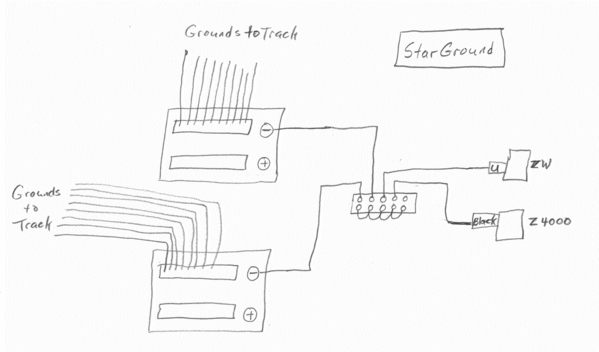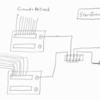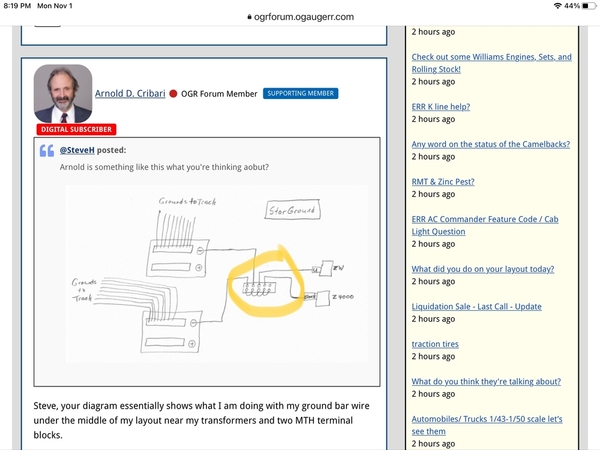Arnold my layouts and experience has always been with conventional operation. I would be hesitant to give you a definitive answer with these DCS questions, as I don’t really know the in’s and out’s of their requirements.
@Arnold D. Cribari posted:Yes, the MTH TB red post for the outer loop is getting power from the right Z4000 throttle (A terminal) with DCS, and the MTH TB red post for the inner loop is getting power from the left Z4000 throttle (D terminal) with DCS.
The black post for each MTH TB has a wire that is connected to a nearby terminal strip for the ground bus wire.
What do you think of this?
I'm confused as to why you're using a ground bus wire and terminal strips for this setup.
Wouldn't it be easier to just run a black wire from the black posts on the rear of your Z-4K (possibly the B and C terminals) to the respective black posts on each of your MTB's and then just run a paired, stranded wire from each post on the MTB to each power drop or whatever you're powering ?
Attachments
@SteveH posted:
Steve, your diagram essentially shows what I am doing with my ground bar wire under the middle of my layout near my transformers and two MTH terminal blocks.
Since my layout is fairly long, about 35 to 40 feet, the ground bar wire runs the entire length of it and has about 7 or 8 terminal strips spaced 10 to 12 feet apart, which connected to the 14 gauge stranded ground bar wire and the 16 gauge solid ground drop wires from the lock-ons.
@Richie C. posted:I'm confused as to why you're using a ground bus wire and terminal strips for this setup.
Wouldn't it be easier to just run a black wire from the black posts on the rear of your Z-4K (possibly the B and C terminals) to the respective black posts on each of your MTB's and then just run a paired, stranded wire from each post on the MTB to each power drop or whatever you're powering ?
Ritchie, thanks for your input.
I used the ground bus wire and terminal strips to reduce the length and amount of wires under my layout and near my transformers.
Your idea of using paired wire would also reduce the number of wires under the layout but, if I understand your approach correctly, I would need a lot more MTH Terminal Blocks (MTH TBs) than the two 12 post MTB TBs that I currently have. Also, I have a lot of lock-ons (35) on my 40 foot layout with 2 main line loops with 4 reverse loops (one on each end) and 9 sidings. I believe if I did what you propose, I would have a lot more long wires under my layout than what I will have when I complete my re-wiring scheme.
Arnold, this below is different than you had described previously.
My concern is if you have the highlighted TB and used the 18 solid as your jumper you may have a potential overheating & overloading situation. You may want to consider making these jumpers out of 14 stranded and crimped lugs.
Attachments
Rich Wiemann, I misunderstood Richie C's diagram.
What I have is 14 gauge stranded insulated wire connecting a ground (U) post of each of the two Z4000 transformers to the main black ground post of the MTH Terminal Blocks. There is no 18 gauge wire between the transformers and MTH Terminal Blocks. Therefore, I don't think I have an overloading problem.
@Arnold D. Cribari posted:Steve, your diagram essentially shows what I am doing with my ground bar wire under the middle of my layout near my transformers and two MTH terminal blocks.
Since my layout is fairly long, about 35 to 40 feet, the ground bar wire runs the entire length of it and has about 7 or 8 terminal strips spaced 10 to 12 feet apart, which connected to the 14 gauge stranded ground bar wire and the 16 gauge solid ground drop wires from the lock-ons.
I think your scheme, Steve, would work well with a more square shaped layout where MTH Terminal Blocks would be in the center.
Arnold ![]()
A few things about re-wiring in general.
Electrical tape often comes undone in a couple days. I'm going to use wire nuts to re-connect wires wherever I crimped and soldered wires together and applied electrical tape over the connection, which I can do fairly easily because I have plenty of slack in my wires.
Patience is a virtue when re-wiring a medium to large size layout. IMO, it is a big mistake to rush a re-wiiring project. I try my best to keep my wits about me and remain ruthlessly rational throughout the project.
It's a very good idea to make a diagram of the re-wiring you want to do. That was a great idea someone else shared on this thread.
Take your time to carefully label the wires so if any get disconnected, you know the correct way to re-connect them.
Don't give up if mistakes happen early on and/or the project seems to take forever. For me, the beginning was the hardest part. Later on, you get into a good routine and find that the project is moving along more quickly than it did at the beginning with much fewer mistakes.
Get good equipment like a good soldering gun. I recently spoke to a Forum member with a great layout who recommended a Weller Professional D 550. I got it and it works great; much more powerful than the prior soldering iron I was using.
@Arnold D. Cribari posted:Ritchie, thanks for your input.
I used the ground bus wire and terminal strips to reduce the length and amount of wires under my layout and near my transformers.
Your idea of using paired wire would also reduce the number of wires under the layout but, if I understand your approach correctly, I would need a lot more MTH Terminal Blocks (MTH TBs) than the two 12 post MTB TBs that I currently have. Also, I have a lot of lock-ons (35) on my 40 foot layout with 2 main line loops with 4 reverse loops (one on each end) and 9 sidings. I believe if I did what you propose, I would have a lot more long wires under my layout than what I will have when I complete my re-wiring scheme.
You're right that it would use slightly more wire and longer runs but, to me, those are non-issues and more than offset by, a) only having to essentially make one connection from the MTB to the lock-on versus having to make two connections to the lock-on doing it your way - positive from the MTB to the lock-on and negative from the ground terminal strip to the lock-on and b) the ease of identifying which wire goes to which lock-on if you ever have an issue (the MTB comes with a nice pre-printed sheet so you can list which port goes to which connection) - your way you have to make up your own sheet (not a big deal), but then identify which two wires are going to each lock-on.
If running out of ports on the 12 port MTB is an issue, you have two alternatives - one, you can string (daisy chain) together multiple 12 port MTB's by simply using one port on the first MTB to connect to the red and black posts on the next MTB or you can always go to the 24 port MTB's, which would give you 24 lock-on connections per handle/loop and, of course, you can always string more 12 or 24 port MRB's to those if you don't have enough.
@Richie C. posted:...If running out of ports on the 12 port MTB is an issue, you have two alternatives
@Arnold D. Cribari adding to Richie's list of options, a third option (if you're not already doing this) would be use each screw terminal on the MTB to connect two wires each.
3R’s “remain ruthlessly rational” great advice during a project such as yours or anybody’s learning experience.
thx for that Arnold it a mantra I will take to work these days.
very impressed with your perseverance!
all my best….
Today, I awakened the Frankenstein monster and applied power to the largely, but not completely, rewired layout. Initially, the inner main loop ran fine, but not the outer main loop.
After 2 or 3 hours, I finally discovered one wire in the wrong position. When I corrected that, the outer loop also ran fine.
Next problem I need to solve is a Passing Siding that gets no power. I'm not sure, but I think the problem has to do with an Atlas Heavy Duty (HD) Switch not working, probably because of a short. They are on back order at Atlas so I see I'll need to hunt one down to replace the burnt out Atlas switch.
Problem with the passing siding is solved. On a relatively new piece of tubular O Gauge track, the insulation (between the center rail and the metal tie) was out of position so the metal tie was touching the rail. This is the 1st time this has happened in my 6 decades of model railroading. I repositioned the piece of insulation so it was where it's supposed to be.
It took me about 2 hours in the early morning hours (ideas for solving the problem came to me in the middle of the night) going through a process of elimination to diagnose the cause of the short in the passing siding.
I still have more to do in this re-wiring project, but I am now well over the hump, and am a lot more productive than when I started.
The crawling king snake (me) will be crawling on the basement floor a lot less, and even that is less of a PITA. LOL.
The rest of the re-wiring will be less tedious and burdensome, more satisfying (I feel like I've acquired more skills and better tools, including a high quality soldering gun), and even fun at times.
However, it still looks like a rat's nest of wires, just a substantially smaller rat's nest than before. LOL.
I've seen in person, and on this Forum thread, extraordinarily well organized wiring systems under masterfully built layouts, and wonder, at this point, if I will ever even approach that level of wiring.
Arnold….great that you fixed the siding issue. Yes, insulating piece issues are few and far between. Even with that track record I still use my multimeter to check between the hot and outside rail before installing.
Oh well, it may not be the neatest but if its functional that’s all that matters. All the trains care about is getting the hot to the center rail and the return back to the transformer. Just run them and look at the journey you made in less than two weeks.
All electrical problems can be resolved with two agendas😁
KISS…keep it stupid simple😃…translation: start with the simple stuff first…is it plugged in?; is it getting voltage or current? Should it be?
Second-Don’t let the smoke out…unless it’s supposed to smoke😁
glad you got your issue solved.
I’m still trying to squeeze 25 hours out of the day to get Time to work on my new Distribution panel…had both Grandchildren for the last 7 weekdays-so no alone time there
Then the weekend 😀Wife had projects-obviously they included me 👍
Then today-she drove over a deer two others just drove over right after someone else hit it…it ripped the wiring harness for the fuel gauge off —so naturally she assumed someone siphoned all her gas when she wasn’t looking😀
So, now the insurance is involved
And I wonder, why does God keep sending the Fates to take away my Time for non model railroading activities???
anyway…
Switch power Depending on what light bulbs your using on the switches, you have an abundance of electrical supply. How many switches can you operate at once? Cheers Charlie
@fastman posted:Switch power Depending on what light bulbs your using on the switches, you have an abundance of electrical supply. How many switches can you operate at once? Cheers Charlie
Charlie, I use 18 volt blue tinted LEDs in the 022 switches and 18 volt incandescent bulbs in the controllers. The 16 remote control 022 switches haved fixed voltage plugs and are independently powered by a ZW used exclusively for the 022 switches, so you are correct in saying I have an abundance of power for the switches. Arnold
The following is a puzzle for you electrical geniuses out there.
One of my goals for this re-wiring project was to eliminate a voltage drop and resulting slowdown/stop of my conventional locomotives in 1 spot and in 1 direction of my layout.
I share this here because I suspect I'm not alone and that many of us have, or had, similar voltage drops.
I will post a video of this later, but for the moment, will share some information about the voltage drop.
The location is in "My Little Town" at the far left side of my layout where 2 reverse loops (1 for the inner loop and 1 for the outer loop) converge, and where I have 4 crossing gates activated by insulated track sections.
The 4 crossing gates draw power directly from a ZW, not the track.
The reverse loops are independently powered by the throttles of a Z4000.
Now it gets interesting: the voltage drop only occurs on the reverse loop for the outer main loop, not the inner main loop, of the layout and only in 1 direction. Specifically, it occurs when the locomotive is running counter-clockwise, not clock-wise, through that reverse loop, and on, and in the vicinity of, the 022 switch. All 022 switches are independently powered by a 2nd ZW.
To be even more specific, this morning I ran a Williams NW2 diesel at 8 volts, and the amps were 1.0 amp that dropped to .7 amp near that 022 switch. The diesel slowed down, almost stopped, but did not stop, at that switch.
There is no slow down when running an MTH Proto 2 or 3 on DCS.
What is your answer to this puzzle?
Arnold








